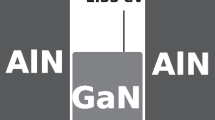Abstract
Zinc oxide nano-particles have been used by cosmetic industry for many years because they are extensively used as agents to attenuate (absorb and/or scatter) the ultraviolet radiation. In the most UV-attenuating agent is formulated in which the metal oxide nano-particles are incorporated into liquid media or polymer media are manufactured, such as sunscreens and skin care cosmetics. In this paper we study the wavelength dependence on the particle size (r eff = 10–100 nm) by solving the scattering problem of hexagonal ZnO particle for different shapes (plate, equal ratio, column) using the discrete dipole approximation method to find the absorption, scattering, and extinction efficiencies for the UV region (30–400 nm). A new modified hexagonal shape is introduced to determine the scattering problem and it is assumed in this study that the wavelength is comparable to the particle size. From these results, we conclude that the optimum particle radius to block the UV radiation is between r eff = 40–80 nm.
Similar content being viewed by others
References
Borns M. and Wolf E. (1980). Principle of Optics.. Pergamon Press, Oxford
Conway J.H. and Sloane N.J.A. (1999). Sphere Packings, Lattices and Group. Springer-Verlag, New York
Dakhel A.A. (2001). Optical constants of evaporated gadolinium oxide. J. Opt. A: Pure Appl. Opt. 3: 452–454
Dakhel A.A. (2003). Structure, refractive index dispersion and optical absorption properties of evaporated Zn–Eu oxide films. Mater. Chem. Phys. 81: 56–62
Hopkins T. (1995). The Parallel Iterative Methods (PIM) package for the solution of systems of linear equations on parallel computers. Appl. Num. Maths. 19: 33–50
Draine B.T. (1998). The discrete-dipole approximation and its application to interstellar graphite grains. Astrophys. J. 333: 848–872
Dranie B.T. (2000). The discrete-dipole approximation for light scattering by irregular targets. In: Mishchenko, M.I., Hovenier, J.W. and Travis, L.D. (eds) Light scattering by Nonspherical Particles: Theroy, Measurements, and Geophysical Applications, pp 131–145. Academic Press, N.Y.
Draine B.T., 2004a. Princeton University Observatory, Princeton NJ, 08544–1001 and Flatau P.J., University of California, San Diego, Scripps Institution of Oceanography, La Jolla, California 92093–0221, USA. Program DDSCAT6.1
Draine B.T. & P.J. Flatau, 2004b. User Guide for the Discrete Dipole Approximation Code DDSCAT.6.1. http://arxiv.org/abs/astro-ph/xxx
Draine B.T. and Flatau P.J. (1994). The discrete dipole approximation for scattering calculations. J. Opt. Soc. Am. A 11: 1491–1499
Draine B.T. and Goodman J. (1993). Beyond Clausius-Mossotti: Wave propagation on a polarizable point lattice and the discrete dipole approximation. Astrophys. J. 405: 685–697
Dulub O., Boatner L.A. and Diebold U. (2002). STM study of the geometric and electronic structure of ZnO(0001)-Zn, (0001′)-O, (101′0), and (112′0) surfaces. Surf. Sci. 519: 201–217
Fairhurst D. & M.A. Mitchnick, 1997. In: Lowe N.J., Shaath N.A. and Pathak M.A. eds. Sunscreens; Development, Evaluation, and Regulatory Aspects. 2nd edn. Marcel Dekker, New York, p. 313
Flatau P.J. (1997). Improvements in the discrete-dipole approximation method of computing scattering and absorption. Opt. Lett. 22: 1205–1207
Forouhi A.R. & I. Bloomer, 1991. In: E.D. Palik, ed. Handbook of Optical Constants of Solids II, Calculation of optical constants n and k in the interband region. Academic Press, New York, Chapter 7, pp. 151–175
Heavens O.S. (1991). Optical Properties of Thin Film. Dover, New York
Jackson J.D. (1975). Classical Electrodynamics. Wiley, New York, 152
Kim S.Y. (1996). Simultaneous determination of refractive index, extinction coefficient and void distribution of titanium dioxide thin film by optical methods. Appl. Opt. 35: 6703–6707
Kozasa T., Blum J. and Mukai T. (1992). Optical properties of dust aggregates: I. Wavelength dependence. Astron. Astrophys. 263: 423–432
Markel V.A., Shalaev V.A., Stechel E.B., Kim W. and Armstrong R. (1996). Small-particle composites I. Linear optical properties. Phys. Rev. B 53: 2425–2436
Meyer B. and Marx D. (2003). Density-functional study of the structure and stability of ZnO surfaces. Phys. Rev. B67: 035403
Peterson A.F., S.L. Ray, C.H. Chan, and R. Mittra, 1991. In: Sarkar T.K., ed. Application of Conjugate Gradient Method of Electromagnetics and Signal Analysis, Numerical implementation of the conjugate gradient method and the CG-FFT for electromagnetic scattering. Elsevier, New York, Ch. 5
Petravic M. and Kuo-Petravic G. (1979). An ILUCG algorithm which minimizes in the euclidean norm. J. Computational Phys. 32: 263–269
Press W.H., Flannery B.P., Teukolsky S.A. and Vetterling W.T. (1986). Numerical Recipes. Cambridge University Press, Cambridge
Purcell E.M. and Pennypacker C.R. (1973). Scattering and absorption of light by nonspherical dielectric grains. Ap. J. 186: 705–714
Segelstein D. (1981). The Complex Refractive Index of Water. University of Missouri, Kansas city, USA
Shore R.E. (1990). Overview of radiation-induced skin cancer in humans. Int J. Radi. Biol. 57: 809–827
Swanepoel R. (1983). J. Phys. D: Appl. Phys. 10: 1214
Hulst H.C. (1957). Light scattering by small particles. Wiley, New York
(1992). Bi-CGSTAB: A fast and smoothly converging variant of Bi-CG for the solution of nonsymmetric linear systems. SIAM J. Sci. Statist. Comput. 13: 631–644
Wood D.M. and Ashcroft N.W. (1982). Quantum size effect in the optical properties of small metallic particles. Phys. Rev. B 25: 6255–6274
Xing Z. and Hanner M.S. (1997). Light scattering by aggregate particles. Astron. Astrophys. 324: 805–820
Author information
Authors and Affiliations
Corresponding author
Rights and permissions
About this article
Cite this article
Al-Hilli, S.M., Willander, M. Optical Properties of Zinc Oxide Nano-particles Embedded in Dielectric Medium for UV region: Numerical Simulation. J Nanopart Res 8, 79–97 (2006). https://doi.org/10.1007/s11051-005-8024-2
Received:
Accepted:
Published:
Issue Date:
DOI: https://doi.org/10.1007/s11051-005-8024-2




